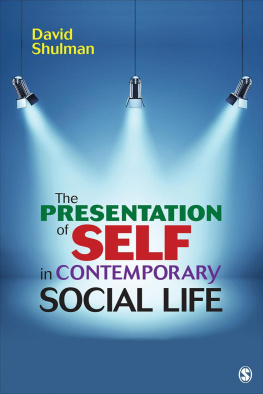Copyright 2017 by SAGE Publications, Inc.
All rights reserved. No part of this book may be reproduced or utilized in any form or by any means, electronic or mechanical, including photocopying, recording, or by any information storage and retrieval system, without permission in writing from the publisher.
FOR INFORMATION:
SAGE Publications, Inc.
2455 Teller Road
Thousand Oaks, California 91320
E-mail: order@sagepub.com
SAGE Publications Ltd.
1 Olivers Yard
55 City Road
London, EC1Y 1SP
United Kingdom
SAGE Publications India Pvt. Ltd.
B 1/I 1 Mohan Cooperative Industrial Area
Mathura Road, New Delhi 110 044
India
SAGE Publications Asia-Pacific Pte. Ltd.
3 Church Street
#10-04 Samsung Hub
Singapore 049483
Acquisitions Editor: Jeff Lasser
Editorial Assistant: Alexandra Croell
Production Editor: Libby Larson
Copy Editor: Beth Hammond
Typesetter: Hurix Systems Pvt. Ltd.
Proofreader: Sarah J. Duffy
Indexer: Joan Shapiro
Cover Designer: Candice Harman
Marketing Manager: Jenna Retana
Printed in the United States of America
Library of Congress Cataloging-in-Publication Data
Names: Shulman, David, author.
Title: The presentation of self in contemporary social life / by David Shulman, Lafayette College.
Description: Los Angeles : SAGE, [2017] | Includes bibliographical references and index.
Identifiers: LCCN 2015046005 | ISBN 9781483319438 (pbk. : alk. paper)
Subjects: LCSH: Social interaction. | Self-presentation. | Symbolic interactionism.
Classification: LCC HM1111 .S487 2017 | DDC 302dc23 LC record available at http://lccn.loc.gov/2015046005 This book is printed on acid-free paper.
16 17 18 19 20 10 9 8 7 6 5 4 3 2 1
Authors Note
Some readers may pick up this book interested in coverage of specific dramaturgical concepts. If so, I want to clarify up front that I do not cover Erving Goffmans concepts in the chronological or sequential order of his publications. Instead, the book begins with a broad overview of the dramaturgical approach where I cover introductory ideas such as front and backstage and spoiled identity. In subsequent chapters, I then address ideas across the dramaturgical canon, from both Goffman and other scholars. I also define ideas in the books glossary. For reference, here is a sense of the dramaturgical and related concepts addressed in the later chapters:
Chapter Four: Workplaces as Stages
Interaction Order, Definition of the Situation, Deep and Surface Acting, Discrediting, Discreditable, Dramaturgical Circumspection, Discipline and Loyalty, Emotional Labor, Line, Organizational Underlife, Performance Teams and Team Collusion, Secondary Adjustments, Social Establishments, Own and the Wise, Total Institutions, Working Consensus
Chapter Five: Modern Life as Show Business
Communicating Out of Character, Chainscape, Celebrities, Dramaturgical Legibility, Extravagant Expectations, Image, Front and Backstage, Gender Advertisements, Marketing of Images, Mystification, Positive Idealization, Servicescape
Chapter Six: Dramaturgical Involvements in Popular Culture
Encounters, Engrossment, Face-to-Face Interaction, Footing, Frame Analysis, Framings, Interaction Ritual Chains, Keyings, Role Distance, Role Embracement, Situational Harness, Social Phoropter, Supportive and Remedial Interchanges
Chapter Seven: The Internet: Societys Newest Stage
Audience Segregation, Collapsed Back and Front Stages, Deceptive Language, Expression Games, Moral Entrepreneurship, Online Impression Management, Role Engulfment, Stigma, Strategic Interaction
Acknowledgments
Thank you to Jeff Lasser for shepherding this book from proposal to completion. Thank you also to the excellent professionals at SAGE who worked on this book: Alexandra Croell, Beth Hammond, and Libby Larson. Thank you to anonymous reviewers. Sheldon Blackman, Kent Grayson, Rebecca Kissane, Andrea Smith, and Ira Silver all read parts of this manuscript, and I thank you all for your useful insights. Thank you also to Lafayette students who heard some of these ideas in classes and shared their reactions to them. Thank you also to Lafayette College and the Anthropology and Sociology Department for your support of this project. I have read and been inspired by many excellent scholars who write on Goffmans ideas. I want to acknowledge the debt you are owed for all the exciting works you produce that unpack these ideas and explore them empirically. Finally, I thank my wife Susan, and son Alex, for bearing with me through the writing and for discussing the books ideas.
SAGE was founded in 1965 by Sara Miller McCune to support the dissemination of usable knowledge by publishing innovative and high-quality research and teaching content. Today, we publish more than 850 journals, including those of more than 300 learned societies, more than 800 new books per year, and a growing range of library products including archives, data, case studies, reports, and video. SAGE remains majority-owned by our founder, and after Saras lifetime will become owned by a charitable trust that secures our continued independence.
Los Angeles | London | New Delhi | S ingapore | Washington DC
The Show Must Go On: Exploring Presentation of Self in Contemporary Society
Introduction: Goffmans Ideas in the 21st Century
In 1959, Erving Goffman published The Presentation of Self in Everyday Life and popularized the dramaturgical perspective, which uses a theatrical analogy to analyze peoples social interactions. Goffman scrutinized peoples activities as if they were actors performing personas. As a result, he inspired research efforts to explore how people express themselves in order to influence the impressions that observers form about them. Goffman coined concepts to describe aspects and consequences of managing impressions, such as face, front and backstage, stigma, frame analysis, total institutions, interaction order, and the presentation of self. His analytic terms endure in the sociological lexicon and are firmly established as social science canon. This field of study is also referred to as impression management, although many sociologists refer to this perspective in an interchangeable sense as dramaturgical sociology.
Goffmans scholarship advanced beyond applying the dramaturgical analogy. He went on to develop additional analogies of frames, games, and rituals for analyzing social life (Lemert & Branaman, 1997). His applications of these analogies also continue to inspire research into impression management. For example, researchers have focused on how people understand the different frames that organize the experiences that they have and how normals and stigmatized people relate to each other (for additional examples see Chriss, 1995; Lemert & Branaman, 1997; Manning, 1992).













